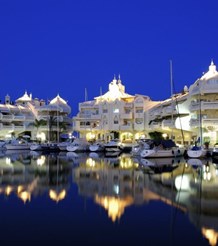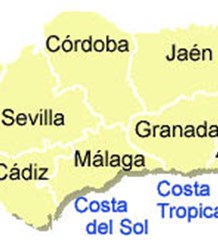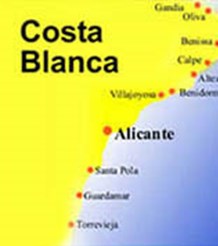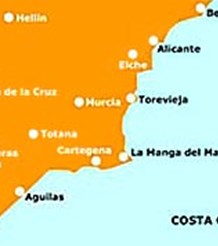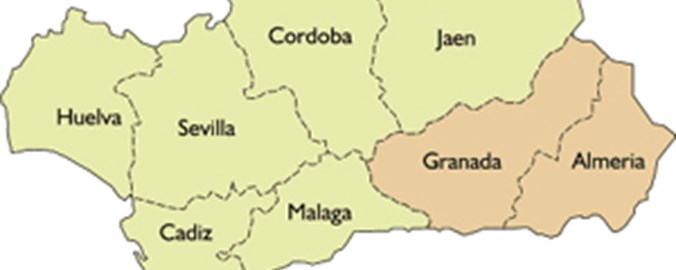
Costa Almeria Information
The province of Almeria is situated in the south east of the Spanish peninsula and borders with the provinces of Granada and Murcia. The province covers 8,774 square kilometers and has a population of 425,000 inhabitants, of which 145,000 live in the capital city, also named Almeria.
The climate of the Costa Almeria is subtropical and the average annual temperature is 18-20°C. The 220 km coastline is accounts for one quarter of the Andalucian coastline. The area has many golf courses and areas of interest to visit, which makes it a very desirable area in which to live.
This province is the hottest in Andalucia with an average of over 3,100 hours of sunshine per year. The hot weather starts from well before Easter and lasts into November.
The area used to lack water and good roads so was not traditionally popular as a tourist destination. However, more recently much investment has gone into improving the infrastructure which has led to increasing numbers of tourists discovering the area today.
The Sierra de Gador range forms a natural protective barrier to the coast, which results in the province being one of the most productive agricultural areas in Europe. More than 10,000 hectares of land is dedicated to flowers and fresh produce, much of which is cultivated under plastic. The resulting 250 million kilos of fresh produce is predominantly exported.
Costa Almeria consists of several regions:
Almeria Area Information
Almeria , the capital of Costa Almeria is situated at the foot of the mountain range and is crowned by the splendid Alcazaba which is an Arab fortress built by the Caliph of Cordoba. In times of war it could hold an army of more than 20,000. Today Almeria is a modern city with a thriving tourist industry. It is home to the international airport for the area.
In 2005, Almeria hosted the Mediterranean Games and a sporting spirit still prevails in the city. It is the perfect place to enjoy all sports - especially water sports such as sailing, windsurfing and rowing.
In Almeria the modern city co-exists with the old town. There is a good selection of art galleries, museums and shops. La Rambla, in the center of the city is a long avenue populated with squares, street cafes and children’s play areas. There is a popular sports marina and a busy ferry terminal from which it is possible to take a trip to North Africa.
The city has been influenced by many civilizations including the Phoenicians, Carthaginians, Romans, Arabs and Christians. Today there are a large number of migrant workers from Morocco and Tunisia giving an African air to the city.
Evidence of the rich history of Almeria can be found throughout the city. Perched on a hilltop overlooking the town is the Alcazaba. It is an imposing Arab fortress once capable of holding an army of more than 20,000 men. Built in the 10th Century by Abd-erRahman 111, the fort dominates the city and affords fabulous views of the area. It is considered to be one of the greatest forts in Andalusia
The Cathedral of Almeria is located in the old part of the city. It is heavily fortified having been built in the 16th century when area was being raided by pirate forces from Turkey and North Africa. The corner towers once held cannons to protect the city’s port. The architecture has both Gothic and renaissance influences. Inside is a wealth of priceless artwork and the tomb of the founder of the cathedral the Franciscan Bishop Diego Fernandez de Villalan.
The parish church of Santiago Apostol in the Calle de las Tiendas is listed as a national monument. Built in 1559 its architecture is a synthesis of Gothic, renaissance and mudéjar styles.
Gastronomic specialities of the area include: Gurullos (stew with pasta), Trigo (stew with grains of wheat, pork, beans and herbs), Gachas (hot and spicy clam stew) and Escabeche e Sardines (fresh sardines in spicy sauce).
As well as cultivating tourism over the past decade, Almeria has become an agricultural center. Here the bulk of the province's fruit and vegetables are grown, much of it for export.
Almerimar Area Information
Almerimar is about 40 kilometers from the city of Almeria, 170 kilometers east from Malaga. Both these airports are served extensively by regular scheduled and charter flights from most European cities.
There is a fine marina in Almerimar, with berths for 1,100 boats up to 60 metres long. The port lies on the west coast of Almeria between Punta de los Banos and Punta Entines in the bay of San Miguel, five miles to the west of Punte Sabinal. The local fishermen provide a good supply of fresh tuna to the many fish restaurants and markets.
A variety of sports is available in Almerimar including: sailing, windsurfing, fishing, tennis, diving, snorkeling, scuba diving and horse riding. In addition, it is home to the well-known Almerimar Golf Course, a favourite to many golfers. The club has an 18 hole golf course and all the necessary facilities such as the hire of clubs and golf buggies.
Almerimar has 13 km of wide sandy beaches and extends into a nature reserve, which is excellent for walking and bird watching.
There is a wide selection of bars, restaurants, supermarkets, souvenir shops and open air markets together with a vibrant nightlife of discos and clubs.
Some of the many places of interest to visit when in Almerimar are:
Las Salinas salt flats
- Las Almoladeras bird sanctuary.
- Cabo de Gata lighthouse.
- The old gold mines in Rodalquilar.
- The Huerbo fortress.
- The town of Sorbas - of early Iberian origin and situated above a tributary of the Rio de Aquas
- Tabernas desert where you can visit Mini Hollywood.
Roquetas de Mar Area Information
Roquetas de Mar was once a fishing village but is now a holiday resort and one of the areas main tourist attractions. Roquetas de Mar is situated 25 km west of Almeria and 160 km east of Malaga and has 8 km of wide sandy beaches along its coastline. The airport at Almeria is just 30 minutes away. It has a population of over 65,000 and is rising making it the fastest grown Mediterranean City in Andalucia.
The salt lagoons which begin at Las Marinas which is 4 km south of Roquetas de Mar is part of the Natural Park and its salt marshes attract many species of birds, including flamingos who come here to breed.
Away from the coast Roquetas de Mar is well known for its intensive greenhouse farming although tourism is still the main income.
Roquetas de Mar is also known for its golf courses and boasts of its own splendid 18 hole course but is also within 20 km of Almerimar and La Envia Golf. There are excellent facilities for all kinds of water sports including water-skiing, jet-skiing, swimming, fishing, diving, sailing etc.
The historic center contains several monuments such as the church or Nuestra Senora del Rosario from the 17th century, the castle of Roquetas and the Arab watchtower of Cerrillos.
There is a small marina which is surrounded by typical Spanish tapas bars and restaurants many specialising in fish dishes which bought in fresh each day by the local fishermen.
There is an abundance of bars, restaurants and hotels catering for all nationalities and souvenir shops which sell all kinds of local crafts. There is also a mini train which is available to explore the resort.
Sierra Nevada East
Most of the Sierra Nevada mountain range is in Almeria province. This area is a nature lover’s paradise and is popular for all kinds of sports including horse trekking, mountain climbing, walking, hang gliding and many more. The Alpujarra makes up a large part of this region and is quite different from that on the Grenada side.
Mojacar
Mojacar lies at the foot of the Sierra Cabrera Range and is a very quiet and typically Spanish area. Mojacar is mostly an inland location, but there is about 4 km of sandy beach where it meets the coast. The coastal district is under development and now has new complexes, hotels and a variety of bars, shops and restaurants. The inland region consists of whitewashed houses, many with stunning views as it is a steep hilly area.
Cabo de Gata
To the east of the area is the Mojacar region which is backed by the Sierra del Cabo de Gata which is home to the Parque Natural de Cabo de Gata. Again there are many fabulous beaches along the coastline of this region.
Los Filabres
This is mainly a desert area with a very tiny population due to high temperatures and lack of water. Most of the former inhabitants have moved to more densely populated areas in search of employment and an easier life with modern amenities.
Almanzora
This is the chief citrus growing area of the region, but is also renowned for its marble and minerals. The area is steeped in history and there are many remains of prehistoric settlements to be visited.
Los Velez
The Sierra Maria and Los Velez Natural Park are in this region, making it a popular location for walking, horse trekking, climbing and wildlife and bird watching.
Inland Almeria
Here there is an almost lunar landscape of desert, sandstone and dried up river beds. It was very popular for the filming of American style spaghetti westerns and famous films including Lawrence of Arabia, were filmed here. Mini Hollywood or Yucca City just outside the Tabernas Desert are open to the public. Some of the original film sets are still in place but they are in a dilapidated state. Some have been rebuilt and fun Wild West shows are performed on a daily basis for tourists to watch.
The area used to lack water and good roads so was not make it popular with tourists but as that is changing tourists are beginning to “discover” the area.
West of Almeria is the highly developed tourist resorts of Roquetas de Mar and Aqua Dulce. These have all the facilities of any modern resort with plenty of bars, restaurants, shops and nightlife.
Almeria , the capital of Costa Almeria is situated at the foot of the mountain range and is crowned by the splendid Alcazaba which is an Arab fortress built by the Calph of Cordoba. In times of war it could hold an army of more than 20,000.
The Tabernas desert – considered the only true desert in Europe - lies to the north of the town between the Los Filabres and Alhamilla mountains and covers some 11,635 hectares with an average temperature of over 17 degrees.



